










|
 |

Facts About Saguaros


Saguaro Distribution

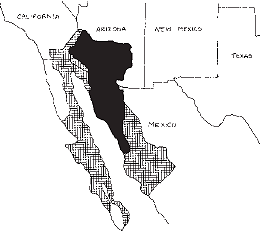 Saguaro cacti, Carnegiea gigantea, only grow in the Sonoran Desert. However, they do not grow in all parts of the Sonoran Desert. The map on the right represents the range of the Sonoran Desert (crosshatch) with an overlay of the range of the saguaro cactus (solid). The range of the saguaro is limited by freezing temperatures in winter. Saguaro cacti, Carnegiea gigantea, only grow in the Sonoran Desert. However, they do not grow in all parts of the Sonoran Desert. The map on the right represents the range of the Sonoran Desert (crosshatch) with an overlay of the range of the saguaro cactus (solid). The range of the saguaro is limited by freezing temperatures in winter.
Saguaros are also limited by elevation. They are generally found growing from sea level to approximately 4,000 feet in elevation. Saguaros growing higher than 4,000 feet are usually found on south facing slopes where freezing temperatures are less likely to occur or are shorter in duration.

[Large Map]

Life of a Saguaro

The Struggle for Survival Begins

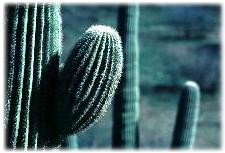 The saguaro begins its life as a shiny black seed no bigger than a pinhead. But what it lacks in size it more than makes up for in numbers. One saguaro produces tens of thousands of seeds in a year, and as many as 40 million in a lifetime of 175 to 200 years. The saguaro begins its life as a shiny black seed no bigger than a pinhead. But what it lacks in size it more than makes up for in numbers. One saguaro produces tens of thousands of seeds in a year, and as many as 40 million in a lifetime of 175 to 200 years.
From the start, the odds against survival are great. Out of all the seeds that a saguaro produces in a lifetime, few will survive to adulthood.
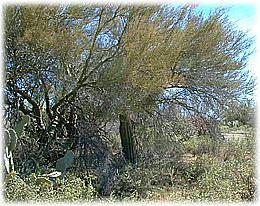 Seeds and young saguaros have the best chance for survival if they are cared for by nurse trees such as palo verde and mesquite. Saguaro seedlings that grow under these sheltering plants are shaded from the desert's intense sunlight, blanketed from winter cold, and hidden from rodents, birds, and other animals that eat them. Rocks provide similar protection for young saguaros. Saguaros do best on bajadas–gently sloping outwash plains at the foot of desert mountains. Seeds and young saguaros have the best chance for survival if they are cared for by nurse trees such as palo verde and mesquite. Saguaro seedlings that grow under these sheltering plants are shaded from the desert's intense sunlight, blanketed from winter cold, and hidden from rodents, birds, and other animals that eat them. Rocks provide similar protection for young saguaros. Saguaros do best on bajadas–gently sloping outwash plains at the foot of desert mountains.
Growth of a Giant

A saguaro's growth is extremely slow. Growth occurs in spurts, with most of it taking place in the summer rainy season each year. The growth rate varies slightly depending on factors such as the annual rainfall of the area. The eastern Sonoran desert around Saguaro National Park receives more rainfall than that of western Arizona, and so the growth rate tends to be higher. By the end of a year 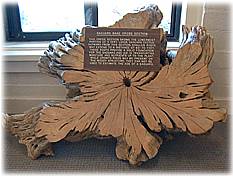 the saguaro seedling may measure only ¼ inch. After 15 years, the saguaro may be barely a foot tall. At about 30 years saguaros begin to flower and produce fruit. By 50 years the saguaro can be as tall as 7 feet. After about 75 years it may sprout its first branches, or "arms". The branches begin as prickly balls, then extend out and upward. the saguaro seedling may measure only ¼ inch. After 15 years, the saguaro may be barely a foot tall. At about 30 years saguaros begin to flower and produce fruit. By 50 years the saguaro can be as tall as 7 feet. After about 75 years it may sprout its first branches, or "arms". The branches begin as prickly balls, then extend out and upward.
By 100 years the saguaro may have reached 25 feet. Saguaros that live 150 years 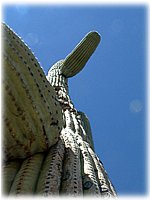 or more attain the grandest sizes, towering as high as 50 feet or more and weighing 10 tons, sometimes more, dwarfing every other living thing in the desert. These are the largest cacti in the United States. Their huge bulk is supported by a strong but flexible cylinder-shaped framework of long woody ribs. or more attain the grandest sizes, towering as high as 50 feet or more and weighing 10 tons, sometimes more, dwarfing every other living thing in the desert. These are the largest cacti in the United States. Their huge bulk is supported by a strong but flexible cylinder-shaped framework of long woody ribs.
Death and Rebirth

Saguaros may die of old age, but they also die of other causes. Animals eat the seeds and seedlings, lightning and winds kill large saguaros, and severe droughts weaken and kill all ages. The saguaro is vulnerable during every stage of its life.
Where there is a balance of life and death, saguaro forests thrive. Until recent years, in some forests in the park, deaths have greatly outnumbered 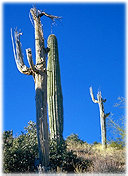 the growth of new young saguaros. What has caused the decline in these areas? the growth of new young saguaros. What has caused the decline in these areas?
Biologists believe killing freezes are the park's major cause of saguaro deaths. The saguaros here are at their extreme northern and eastern range, where the coldest winter temperatures most often occur. Humans, too, have played a part in the decline. Livestock grazing, which continued from the 1880s until 1979, devastated some cactus forests. Seedlings were killed outright by trampling or were unable to find suitable places to grow because the ground had been compacted and nurse plants killed.
Today, with grazing eliminated, recovery of the saguaro is underway in several areas. Thousands of young saguaros have taken hold, and they are thriving. Still, natural forces, vandalism, and cactus rustling – the theft of saguaros for use in landscaping – continue to take a toll on the park's saguaro forests.

Features of the Saguaro
 
Many features assist the saguaro in storing and conserving that most precious of desert commodities – water. Accordion-like pleats allow the saguaro to expand and hold water collected through the roots. Spongy flesh in the trunk and branches serves as a reservoir where water is stored as a slow-to-evaporate gelatin-like substance. Unlike most plants, the saguaro cactus has no conventional leaves, which transpire large amounts of water. The food-making process of photosynthesis normally carried out by green leaves is performed in the trunk and branches. Spines discourage animals from taking the cactus' moisture, shade the plant, and shield it from drying winds. Waxy skin aids in reducing moisture loss.
Saguaro Pleats

The roots of a saguaro grow out from the plant in a radial fashion, several inches under the ground. During a heavy rain, a saguaro will absorb as much water as its root system allows.
 To accomodate this potentially large influx of water, the pleats expand like an accordion. Conversely, when the desert is dry, the saguaro uses its stored water and the pleats contract. To accomodate this potentially large influx of water, the pleats expand like an accordion. Conversely, when the desert is dry, the saguaro uses its stored water and the pleats contract.
Because the majority of a saguaro is made up of water, an adult plant may weigh 6 tons or more. This tremendous weight is supported by a circular skeleton of inter-connected, woody ribs.
The number of ribs inside the plant correspond to the number of pleats on the outside of the plant. As the saguaro grows, the ribs will occasionally fork and the corresponding pleat will also fork at the same place.
Why Some Saguaros are Crested

Even when saguaro cacti grow in their normal form, they rarely grow symmetrically. Saguaros sometimes grow in odd or mis-shapen forms.  The growing tip occasionally produces a fanlike form which is referred to as crested or cristate. The growing tip occasionally produces a fanlike form which is referred to as crested or cristate.
Though these crested saguaros are somewhat rare, over 25 live within the boundaries of the park. Biologists disagree as to why some saguaros grow in this unusual form. Some speculate that it is a genetic mutation. Others say it is the result of a lightning strike or freeze damage. At this point we simply do not know what causes this rare, crested form.

How the Saguaro Collects Water

The saguaro collects water with a network of roots that lies about 3 inches below the surface and stretches as far out from the main stem as the saguaro is tall. In a single rainfall, these shallow roots–along with special small root hairs that grow moisture–may soak up as much as 200 gallons of water, enough to last the saguaro a year.
The Saguaro's Flowers, Fruit, and Seeds

The saguaro flower forms a cluster of creamy white petals around a dense group of yellow stamens on a 4 inch long stem. The saguaro has more stamens per flower than any other cactus flower.
 The flowers of the saguaro–big, bold, and numerous–bloom and color the desert in late April, May, and June. Each blossom opens in the cool of the night a few hours after the sunset. By the next afternoon, the flower has wilted, and the brief period of bloom ended. The spectacle repeats itself night after night for about four weeks until as many as one hundred flowers have appeared on each saguaro.
The flowers of the saguaro–big, bold, and numerous–bloom and color the desert in late April, May, and June. Each blossom opens in the cool of the night a few hours after the sunset. By the next afternoon, the flower has wilted, and the brief period of bloom ended. The spectacle repeats itself night after night for about four weeks until as many as one hundred flowers have appeared on each saguaro.
Pollination

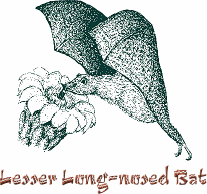 In the few hours the flowers are open a variety of flying animals will have succeeded in pollinating many of them. Whitewinged doves and longnose bats–summer migrants from Mexico–honeybees, and moths accidentally become powdered with sticky pollen as they feed on the sweet nectar inside the flower. As they travel from flower to flower, they transport the pollen, fertilizing as they go. A saguaro can only be fertilized by pollen from another cactus. If fertilization has taken place, a fruit will begin to form at the base of the flower. In the few hours the flowers are open a variety of flying animals will have succeeded in pollinating many of them. Whitewinged doves and longnose bats–summer migrants from Mexico–honeybees, and moths accidentally become powdered with sticky pollen as they feed on the sweet nectar inside the flower. As they travel from flower to flower, they transport the pollen, fertilizing as they go. A saguaro can only be fertilized by pollen from another cactus. If fertilization has taken place, a fruit will begin to form at the base of the flower.
Fruit

In June and July the fruit of the saguaro ripens. The sugary pulp of each fruit can contain more than 2,200 seeds. Javelinas, coyotes, foxes, squirrels and other rodents, harvester ants, and many birds feast on the fruit and seeds.
The Saguaro as a Home

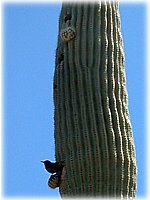 The saguaro is like a multi-storied apartment complex: many animals live in close quarters and the occupants change constantly. Two common residents are the Gila woodpecker and gilded flicker. These birds dwell in nest holes they make in the trunk and larger branches of saguaros. The birds excavate new holes each spring, and they often make and reject several cavities in one nesting season before settling in one and raising a family. Their industriousness leaves many holes for other animals, who rapidly move in. The birds who compete for the homes include American kestrel, Lucy's warblers, cactus wrens, western kingbirds, phainopeplas, elf owls, and purple martins. Honeybees also inhabit some holes. For residents, the holes are a retreat from desert temperature extremes. Well insulated by thick walls, the holes are as much as 20º F cooler in the summer and 20º F warmer in the winter than outside. Other saguaro dwellers live not in holes but in bulky nests. These include red-tailed hawks and Harris' hawks. The saguaro is like a multi-storied apartment complex: many animals live in close quarters and the occupants change constantly. Two common residents are the Gila woodpecker and gilded flicker. These birds dwell in nest holes they make in the trunk and larger branches of saguaros. The birds excavate new holes each spring, and they often make and reject several cavities in one nesting season before settling in one and raising a family. Their industriousness leaves many holes for other animals, who rapidly move in. The birds who compete for the homes include American kestrel, Lucy's warblers, cactus wrens, western kingbirds, phainopeplas, elf owls, and purple martins. Honeybees also inhabit some holes. For residents, the holes are a retreat from desert temperature extremes. Well insulated by thick walls, the holes are as much as 20º F cooler in the summer and 20º F warmer in the winter than outside. Other saguaro dwellers live not in holes but in bulky nests. These include red-tailed hawks and Harris' hawks.
Learn more about the animals of Saguaro National Park on our Animals page.
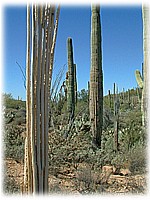 People's Use of the Saguaro People's Use of the Saguaro

For centuries peoples of the Sonoran Desert have used natural products of the saguaro. In the summer the saguaro provided a nourishing bounty of juicy, fig-like fruits. Native Tohono O'Odham Indians harvested them by knocking them off the tall cacti with long poles. From the fresh fruit the Tohono O'Odhams made jam, syrup, and, for their religious ceremonies, wine. So important was the fruit to the Tohono O'Odhams that the season of harvest marked the beginning of their new year. The saguaros also provided seeds for the Tohono O'Odhams and their chickens to eat, and strong woody ribs, which the plant uses to support its huge weight, to build shelters and fences.

Saguaro Cacti Stats


 Classification Classification

Kingdom
Subkingdom
Superdivision
Division
Class
Subclass
Order
Family
Cactus Group
Genus
Species
|
Plantae
Tracheobionta
Spermatophyta
Magnoliophyta
Magnoliopsida
Caryophyllidae
Caryophyllales
Cactaceae
Cereus
Carnegiea
Carnegiea gigantea
|
Plants
Vascular plants
Seed plants
Flowering plants
Dicotyledons
Cactus
Saguaro
|
 Location Location

Location
Range

Westernmost
Northwesternmost
Easternmost
Southernmost
Elevation
Habitat

Soil
Densest Forest
|
Sonoran Desert  (map) (map)
S AZ, Sonora, SE CA (3 isolated sparse
sites along the Colorado)  (map) (map)
Colorado River
Hualapai Mountains, near Kingman, AZ
Galiuro Mountains, NE of Tucson, AZ
Rio Mayo, Sonora
0' - 4500'
Desert, esp. sloping foothill bajadas,
relatively frost-free areas
Coarse, gravely, airy, good drainage
Saguaro NP, Tucson Mtn. District
|

 Life Cycle Life Cycle

Seed
2-3 days
6 weeks
>6 weeks
1 year
7 years
10 years
15 years
20 years
25 years
30 years
40 years
50 years
75 years
100 years
125 years
150 years
200+ years
|
Small pinhead-size
Germination
Av. life expectancy - new saguaros (critical period)
<1% live longer
¼" high
Woody ribs appear
1½" - 3" high
9" high
18" high
26" high
Flowers and fruit
7'+ high
12'+ high
Arms begin to grow
30'+ high
36'+ high
41'+ high
Lifespan
|
 Size Size

Weight
Height
Record Height
Seed/Maturity Ratio
Trunk Width
|
10 tons +
50' +
78' (died in 1986)
100's of millions
3' +
|

 Root System Root System

Depth
Length
Water intake
|
3" below the surface
50'+ from the main stem
200 gallons absorbed
during a single rainfall
|
 Flowers Flowers

Size
Stem
Color
Annual production
Bloom period - Species
Bloom period - Individual saguaro
Bloom period - Individual flower
Bloom cycle - Individual flower
|
3" wide
4" long
Creamy white
100
Late April - June
4 weeks
1 day
Late night until
next afternoon
|

 Fruit Fruit

Color
Ripens
Food
|
Deep red
Late June and July
Fruit, syrup, juice, jam
|
 Seeds Seeds

Color
Single fruit production
Annual production
Lifetime production
Survival rate

Germination rate
|
Glossy, reddish-black
2,200+
Tens of thousands
40,000,000
Only a few of all of these
will survive until adulthood
<1 in 1,000
|

 Ribs Ribs

No. of ribs - young saguaro
No. of ribs - adult saguaro
No. of ribs - saguaro arms
|
10 - 13
20 - 30
15+
|

 Animal Use Animal Use

Animal use

Animal hole insulation

Nest dwellers

Hole makers

Other occupants

Pollinators

Eaters – fruit & seed
|
Food, home, shelter, shade, safety

Summer: 20º cooler / Winter: 20º warmer

Red-tailed hawks, Harris' hawks, etc.

Gila woodpecker, gilded flicker, etc.

American kestrel, Lucy's warblers, cactus wrens, western kingbirds, phainopeplas, elf owls, purple martins, bats, bees, insects, etc.

Whitewinged doves, longnose bats, bees, moths, etc.

Javelinas, coyotes, foxes, squirrels, rodents, harvester ants, many birds, etc.
|
 Miscellaneous Miscellaneous

Pronunciation
Color
Tissue
U.S. cacti size rank
Cristate saguaros
More moisture =
Status

Saguaros in Park
|
(sah-WAH-row)
Light olive green
May be 85% water
1
1 in 250,000 (25+ in park)
More saguaro arms
Protected; AZ State Flower;
Park symbol
1.6 million
|

|
|
 |
 |
 |
 |
 |
 |


 Welcome | About Us | Saguaro National Park | News and Events Welcome | About Us | Saguaro National Park | News and Events

Related Info | Kid's Page | How to Help | Contact Us


s i t e d o n a t e d b y

  |









